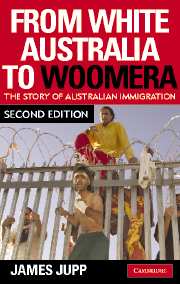Book contents
- Frontmatter
- Contents
- Acronyms and abbreviations
- Introduction
- Chapter 1 Creating an immigrant society, 1788–1972
- Chapter 2 From assimilation to a multicultural society, 1972–2006
- Chapter 3 The Fraser, Hawke and Keating governments, 1975–1996
- Chapter 4 Policy instruments and institutions
- Chapter 5 Multicultural policy
- Chapter 6 The attack on multiculturalism
- Chapter 7 The impact of One Nation
- Chapter 8 Economic rationalism
- Chapter 9 Sustainability and population policy
- Chapter 10 Refugees and asylum seekers
- Chapter 11 Immigration in a global world
- Appendix I Chronology: 1972–2007
- Appendix II Ministers for immigration, departmental secretaries and gross annual settler intake, 1973–2006
- References
- Index
Chapter 3 - The Fraser, Hawke and Keating governments, 1975–1996
Published online by Cambridge University Press: 03 May 2010
- Frontmatter
- Contents
- Acronyms and abbreviations
- Introduction
- Chapter 1 Creating an immigrant society, 1788–1972
- Chapter 2 From assimilation to a multicultural society, 1972–2006
- Chapter 3 The Fraser, Hawke and Keating governments, 1975–1996
- Chapter 4 Policy instruments and institutions
- Chapter 5 Multicultural policy
- Chapter 6 The attack on multiculturalism
- Chapter 7 The impact of One Nation
- Chapter 8 Economic rationalism
- Chapter 9 Sustainability and population policy
- Chapter 10 Refugees and asylum seekers
- Chapter 11 Immigration in a global world
- Appendix I Chronology: 1972–2007
- Appendix II Ministers for immigration, departmental secretaries and gross annual settler intake, 1973–2006
- References
- Index
Summary
The Whitlam government officially ended White Australia and gave its support to the concept of multiculturalism. But this had only a limited immediate effect. The most public enthusiast for multiculturalism, Minister for Immigration Al Grassby, was defeated in Riverina in the 1974 election in a campaign which included racist attacks on him and his policies. His successors, Clyde Cameron and James McClelland, were in an older Labor tradition and promptly reduced the migrant intake at a time of rising unemployment.
Whitlam abolished the Immigration Department altogether in 1974. He recalls that Grassby found it ‘incurably racist’. Functions were redistributed mainly to the Social Security, Education and Labour departments, with Senator McClelland as minister for labour and immigration from June to November 1975. Whitlam explained this as recognising a wider responsibility than organising intake: ‘We had abolished the Department because in our view the Federal Government's responsibility for migrants did not end with recruiting them …but extended into all the areas where my government had taken initiatives, such as education and health and urban services’. This continued to be the view of succeeding governments at least into the 1990s. But they operated with a revived and extended Immigration Department as well as through other relevant departments.
This abolition temporarily removed the core from migrant settlement services which had begun to be built and left multiculturalism with no clear administrative location.
- Type
- Chapter
- Information
- From White Australia to WoomeraThe Story of Australian Immigration, pp. 37 - 56Publisher: Cambridge University PressPrint publication year: 2007



